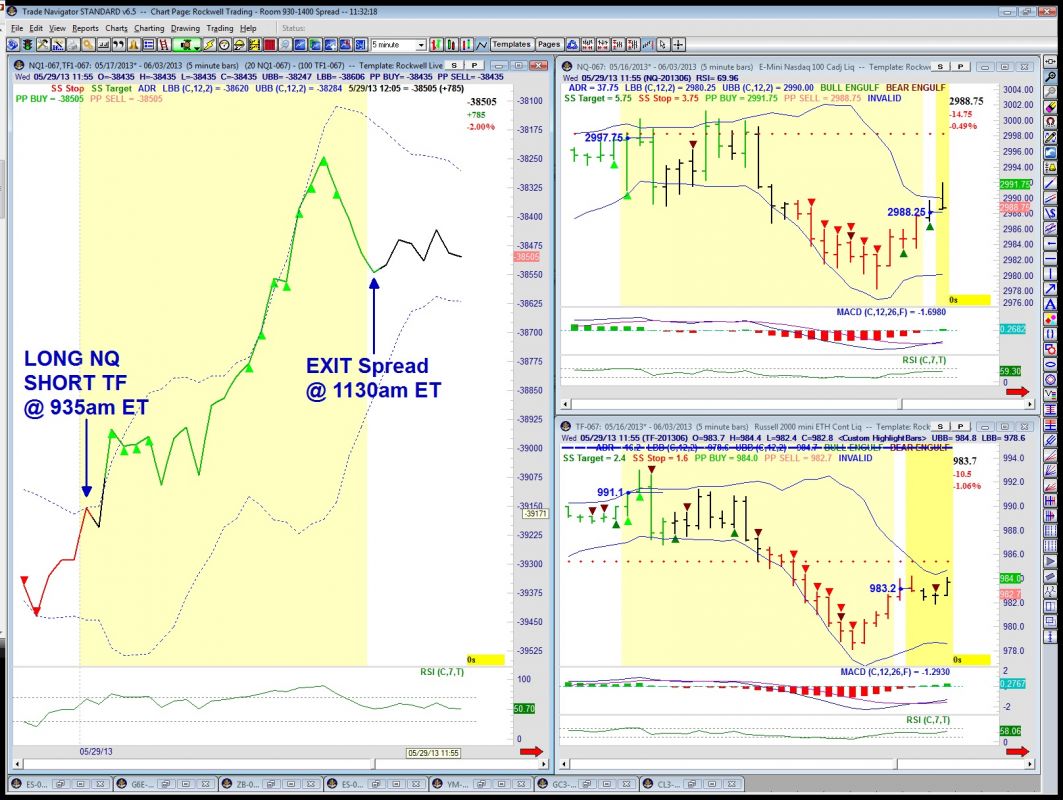Spread trading is a powerful way to capture market moves with relatively low risk.
Unfortunately, many conservative traders shy away from this trading technique because at first glance the concept seems rather complicated. In fact, with a basic understanding of spreads, you’ll discover just how simple spread trading can be.
In this article, you’ll learn what spreads are, how to initiate a spread trade, and a strategy for day trading the Nasdaq 100/Russell 2000 spread.
WHY SPREADS?
Spread trading is great for conservative traders because most spreads are relatively low risk trades. Instead of having complete market exposure by being long or short a given market, an offsetting position is added, reducing the impact of market fluctuations.
Brokers recognize this too, and will typically require much lower margin requirements when trading spreads in leveraged markets (like options and futures). This is a big advantage for traders with smaller accounts because it allows traders to hold positions overnight with relatively low margin requirements.
WHAT IS A SPREAD?
Spread trading is the simultaneous buying and selling of the same, or two like markets. When trading correlated markets there is a tendency for these markets to move in the same manner, so a loss in one market will be offset by a gain in another. If the markets are in perfect “synch”, then there is a true hedge and any gain in one position will equal the loss in the other, resulting in a breakeven trade. In a perfect world, correlated markets exhibit similar moves and behavior, but we know that in reality this is rarely the case. It’s these discrepancies that spread traders look to take advantage of.
INTRAMARKET VS. INTERMARKET SPREADS
Spreads are broken down into two categories: Intramarket & Intermarket. An intramarket spread is a spread that consists of a long and short position in the same market, but with different expirations (this would be the same as a calendar spread). This type of spread applies to options & futures trading and is a great way to capture moves when there is an expectation for a market to move and experience volatility in the near term.
As an example, if you are bullish gasoline heading into the summer months and driving season, you could buy gasoline futures with an expiration in the summer, and sell a contract with an expiration that is further out. If you are bullish heating oil going into the winter, you could initiate the same type of spread strategy.
Intermarket spreads consist of a long and short position in two like markets. A great spread setup for intraday trading exists between the Russell 2000 and the Nasdaq 100. As you might imagine, these indices have a tendency to move together since they both represent baskets of U.S. stocks. Although there is a strong correlation, there tends to be days when one market outpaces the other. You can identify times when one market is moving faster than the other by plotting the spread on a chart (showing the difference between both markets) and using technical analysis.
One of the easiest ways to identify spread trading opportunities in the Nasdaq-Russell spread is to monitor the overnight gap. We’ll use futures for our example (if you’re new to futures the Nasdaq symbol is NQ, the Russell is TF).
Step 1 – Chart the NQ – TF spread on a 5 minute chart. Most major charting packages give you the ability to plot spreads and we’ll need to see the difference (spread) between these two markets to make trading decisions.
Step 2 – Take the previous day’s U.S. day session closing price of the spread at 4:15pm ET. Compare this price to the current session’s spread price at 9:35am ET, after the first completed 5 minute bar. The setup here is to trade in the direction of the gap. If there is a gap down, go short NQ, long TF. If there is a gap up, go long NQ, short TF.
Step 3 – Once you’re in a trade, always know when to get out! With this setup consider a $150 stop loss. Since the morning hours typically show the most movement, you’ll want to try to capture as much of this move as possible, closing the trade at 11:30am ET. If you prefer, you might consider a $300 profit target. This is more conservative and will get you out of trades quicker, but you’ll miss some of the bigger moves that can occur from time to time.
With this setup you’ll notice that the spread continues to widen between these two markets when there is a gap between trading days. Entering after the first 5 minutes helps eliminate some of the noise you would experience otherwise near the open. If things turn around, you should be able to limit your risk to approximately $150. On the other hand, if the spread continues to widen you can hang onto the position throughout the morning session, capturing a pretty decent move between the two markets.

Figure 1 Title: Nasdaq/Russell Spread
Source: Courtesy Trade Navigator
In the example above, the NQ – TF 5 minute spread chart is plotted on the left hand side. The NQ 5 minute chart is on the top right, and the TF 5 minute chart is on the bottom right. Since the spread showed a gap up between the 4:15pm close and 9:35am first bar completion, the goal would be to go long NQ and short TF.
Our positions at 9:35am ET:
LONG NQ at 2997.75
SHORT TF at 991.1
During the session the spread moved against us $50, then continued to move higher throughout the session. At 11:30am ET we can close the spread by selling NQ and buying TF.
Our closed positions look like this:
LONG NQ 2997.5, close at 2988.25 for a LOSS of $190
SHORT TF at 991.1, close at 983.2 for a PROFIT of $790
Although we lost money on the NQ side of the trade, we have a total closed profit of $600 because of the profit in TF (TF profit of $790 – NQ loss of $190 = $600).
Even though both markets moved lower, the TF sell-off was much stronger. In fact, the sell-off in TF was -.80% versus -.32% in NQ. This discrepancy allows us to capture a $600 profit during the first two hours of the trading session. If the spread went against us we would simply close the trade with a $150 loss and look for a new opportunity during the next trading session.
GETTING STARTED
Just as with any strategy it’s important to practice this method on a simulator before trading the setup live. You’ll find that even though the setup and initiating the trade is rather simple, watching spreads and how a profit offsets a loss (and vice versa) can take a little getting used to. The strategy above doesn’t consider trade management or early exits, but at times you’ll find that one side of the trade is moving so strong that you’d prefer to close one half of the trade (known as legging out), turning the spread into a directional trade.
Spread trading is a fascinating concept, and an effective way to trade markets with less market exposure and risk. With a little practice you’ll probably discover that legging in and out of the spread will allow you to maximize your profit potential. Start with these simple rules, and you’ll discover a style of trading that is a great compliment to any serious trader and comprehensive trading plan.




